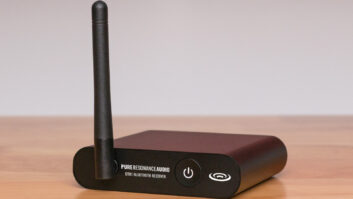Los Angeles, CA – June 2009… When it comes to engineering and recording, few studio items are as critical as one’s reference monitors. The ability to know the sound will be consistent on a variety of playback systems—from earbuds to car systems to home systems—is absolutely essential. For recording engineer and mixer Bill Malina, who during his career has engineered a number of high profile recordings, including Ringo Starr’s Liverpool 8, Alanis Morissette’s Jagged Little Pill Acoustic, and a number of tracks from various Van Halen records, his reference monitors represent the key studio element that must consistently deliver the truth. To ensure there are no unpleasant last minute surprises, Malina relies on his Q12 reference monitors from Equator Audio Research.
The Equator Q12 monitors are a 2-way active system employing Equator Audio’s Zero Point Reference coaxial design. The monitor’s no-slope crossover approach reduces the mid-range distortion associated with conventional coaxial designs and the CPU that resides inside each monitor handles a host of formidable tasks including matching the transducers, as well as seamlessly incorporating the system’s crossover approach. Purchased in March of 2009, Malina has grown very fond of his Q12’s, as he explained.
“My home studio is based around a Euphonix CS2000 console, a Digidesign Pro Tools system, and my Equator Q12’s,� says Malina. “What impresses me most about these monitors is the incredible accuracy of the stereo image, which I find very pleasing, wide, and strong. There’s a tremendous amount of definition, so you can clearly hear the placement of each instrument or voice. The Q12’s overall sound quality is terrific. When you work in the sweet spot provided by these monitors, there’s a presence and level of clarity that’s extremely difficult to achieve with lesser quality monitors.�
Malina was equally complimentary of the Q12’s sonic consistency. “While it’s important to monitor a project at a variety of different levels,� continued Malina, “I have a preference for monitoring at relatively low levels, as it reduces ear fatigue when you’re working for extended periods. Unfortunately, most studio monitors tend to lose the low frequency at reduced volume levels, so before you know it, you have little choice but to work at a level that might not be the best choice for making critical listening decisions. By contrast, this is not the case with my Equator Q12’s. The sound quality is remarkably consistent regardless of whether I’m listening at a loud or a soft playback level. The Q12’s ability to provide the full frequency range at low levels is a huge benefit that seems to elude other manufacturers.�
While Malina acknowledges he has invested considerable time, effort, and money to acoustically optimize his control room, that doesn’t mean there isn’t room for improvement. On that note, he’s become very fond of Equator Audio’s Secondary Reflection Correction™ (SRC) software, which is part of the optional Q Series Room Analysis Calibration Kit.
“My room is quite good to begin with,� says Malina, “but there are still acoustic reflections from the console surface, video monitors, and other hard surfaces that can compromise the mix position. I used the SRC software for two settings—one to optimize the sweet spot at the console and another preset to shift the listening position a few feet back to the sofa behind the console so that producers and others can monitor in comfort. In each case, the results I’ve obtained have been very impressive. The software does a great job of adjusting the EQ curve and compensates for the acoustic characteristics at the back of the room. The end result is a very noticeable improvement in the stereo imaging, which is considerably more detailed than if the settings are disabled.�
While, thus far, Malina’s Q12’s have resided almost exclusively in his personal studio, he knows there will be forthcoming projects that will require him to work in other facilities. With that in mind, he has every intention of carrying his Q12’s with him and optimizing the space with the SRC software. “I’m most excited about the prospect of being able to use the software when I engineer in other facilities,� says Malina, “as this will be an extremely useful tool to ensure that I’m hearing what I need to. The SRC software’s ease of use and capability to optimize the room goes a long way toward ensuring the accuracy of the mix.�
Currently, Malina is working on a new album project for Grammy® Award winning singer, songwriter, musician, composer, and occasional actor Robin Thicke. Before turning his attention back to his work, he offered this assessment of his new Equator Audio Q12’s. “In the three months or so that I’ve been working with my Q12’s, I’ve really become very fond of them,� said Malina. “I love the sound of these monitors. The imaging is first-rate and the ability of the software to compensate for various acoustic shortcomings is a huge benefit toward ensuring my work will translate properly no matter where it plays. With these monitors, I feel confident I can work at most any facility and know with a high degree of certainty what I’m hearing.�
About Equator Audio Research
Equator Audio Research is committed to delivering studio reference monitor solutions that overcome the myriad of challenges faced in today’s production environment. Audible obstacles such as comb-filtering from computer screens and consoles, standing waves, uneven first reflections, asymmetrical speaker placement, and poor low frequency diffusion can easily degrade the listening experience. Equator Audio Research designs products that overcome these challenges. Our products are used daily in mission-critical applications at many of the world’s finest recording studios. For additional information on all Equator Audio products, visit the company online at www.equatoraudio.com.
###







